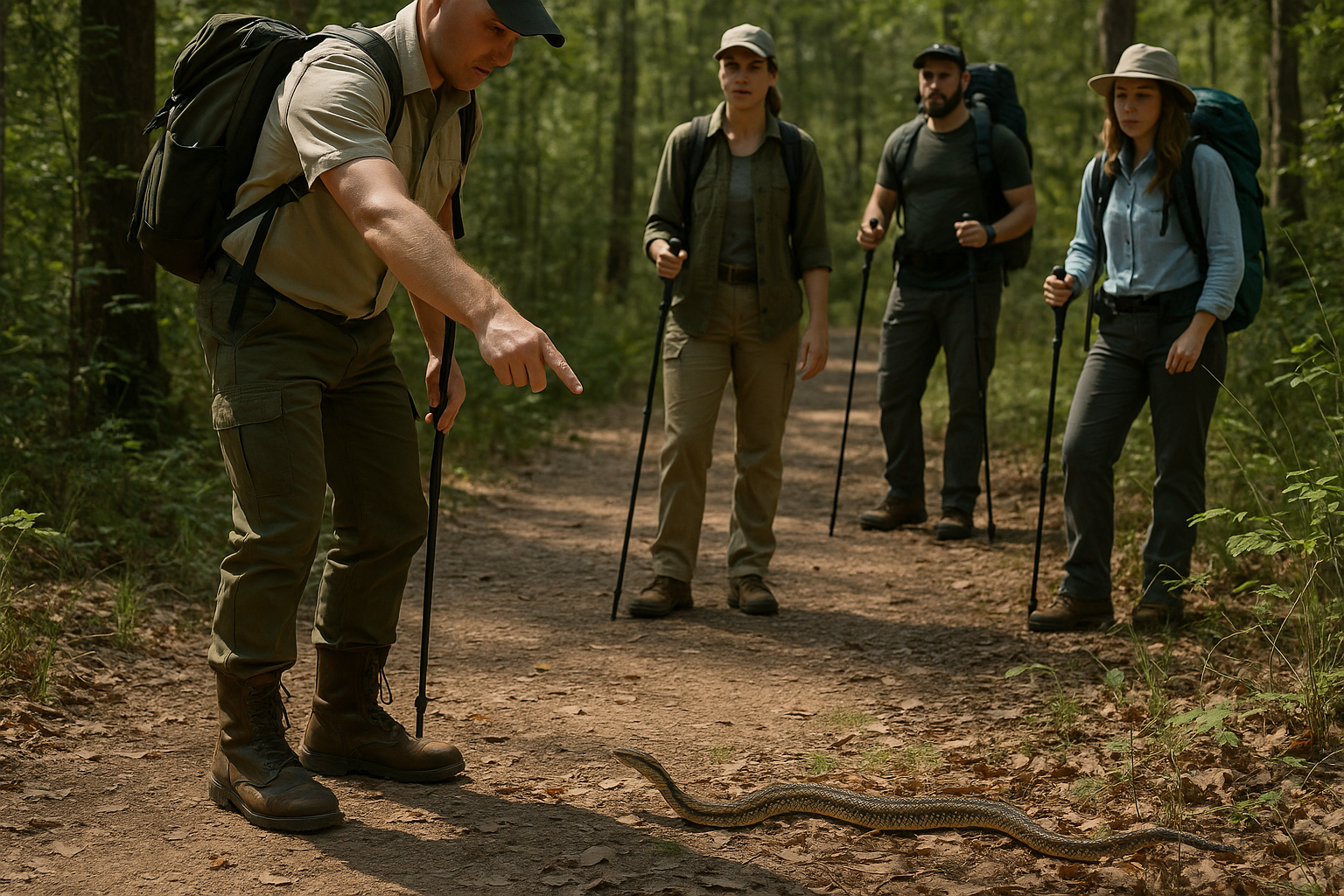Yet, this idyllic imagery is not without its risks and perils. One of these hazards that we frequently overlook – snakes. 🐍 Yes, these slithering creatures often get a bad rap, partly due to our instinctive fear and partly due to lack of understanding. But it’s crucial to remember that, like all elements of the wilderness, they too have a pivotal role in maintaining the ecological balance.
In this in-depth article, we will traverse the terrain of “Snake Safety in the Great Outdoors,” offering insights, dispelling myths, and providing effective safety tips. Aimed at outdoor enthusiasts, hikers, campers, or anyone with a passion for nature, this article will equip you with the knowledge to co-exist safely with these reptiles while also appreciating their unique role in our ecosystem.
So, let’s slither safely into our first section: Understanding snakes. 🧠 Knowledge is power, and this adage holds especially true in this context. Understanding the behavior, habitat, and traits of these creatures can significantly minimize the risk of unpleasant encounters. We will discuss different snake species, their distinguishing features, and their typical habitats – arming you with the wisdom to respect these creatures from a safe distance.
Next, we will focus on the meat of the matter: Snakebite prevention. 🚫 While snakebites are relatively rare, their potential to cause severe injury or even death underscores the importance of prevention. We will provide a comprehensive guide to snakebite prevention, including appropriate clothing and gear, safe camping and hiking practices, and other preventive measures that are indispensable for any outdoor adventure.
Moving on, we will delve into a slightly unnerving yet crucial topic: What to do in the event of a snakebite? 🏥 This section will outline the steps you should take immediately after a snakebite, including first aid measures, when to seek medical attention, and what information to provide to healthcare professionals. While we hope you’ll never need to use this information, it’s crucial to be prepared for any eventuality.
Lastly, we will address a common concern among many outdoor enthusiasts: How can you distinguish between venomous and non-venomous snakes? 🕵️♀️ While it’s not foolproof or recommended to rely solely on physical characteristics to determine a snake’s venomous status, knowing some basic differences can provide additional assistance in certain situations.
By the end of this article, you’ll be better equipped to navigate the wilderness safely, understanding not only how to avoid unwanted encounters with snakes but also how to respond effectively in the unlikely event of a snakebite. More importantly, we hope this will foster a greater respect and appreciation for these oft-misunderstood creatures, reminding us that we are mere guests in their natural habitats. So, let’s embark on this journey of discovery and respect for our slithering counterparts in the Great Outdoors. Stay safe, and happy trails! 🌳
Understanding Your Scaly Friends: An Overview of Snake Safety
As a keen outdoor enthusiast, there is a high probability that you will encounter snakes at one point. These creatures, often seen as menacing, can pose a danger if proper safety measures are not taken. However, if you are well-informed about snake safety, there’s no reason why your outdoor excursions should not be fun and safe. Let’s delve into understanding snakes and how best to interact with them in the great outdoors.
In order to approach snake safety with confidence, it is essential to dispel common misconceptions about these reptiles. Contrary to popular belief, snakes do not actively seek out humans to attack. They are usually defensive creatures, reacting primarily to perceived threats. If you inadvertently stumble upon a snake, the likelihood is that it’s as startled as you are.
Another fact to bear in mind is that not all snakes are venomous. In fact, out of the 3,000 or so snake species worldwide, only around 600 are venomous. This underscores the importance of educating yourself on the different types of snakes you’re likely to encounter in your outdoor activities.
🐍 Distinguishing Between Venomous and Non-Venomous Snakes
Being able to differentiate venomous snakes from non-venomous ones can make all the difference in a snake encounter. While the characteristics may differ from region to region, there are some general pointers to guide you. For example, venomous snakes often have a more triangular or diamond-shaped head, while non-venomous snakes have a rounded head.
However, the ultimate advice is, regardless of the snake type, always keep a safe distance. Snakes, whether venomous or not, can still bite and cause painful, potentially dangerous situations.
The Art of Avoiding Snake Encounters
While it’s important to understand snakes, it’s even more critical to know how to avoid encounters with them. The first step is to be aware of your surroundings. Snakes can camouflage themselves quite well, making them difficult to spot. They prefer places where they can hide, such as tall grass, rocks, and piles of leaves or debris.
When exploring the great outdoors, stick to well-trodden paths where the likelihood of snake encounters is reduced. If you need to move through tall grass or undergrowth, use a stick to disturb the area first. This may scare away any snakes hiding there.
Another crucial tip is to avoid reaching into areas where you can’t see. This includes bushes, tall grass, or piles of leaves where snakes might be hiding. Instead, use tools to move or manipulate objects in such areas.
Video Tip: “Avoiding Snake Bites: How to Hike in Snake Country” by REI
For a more visual guide on avoiding snake encounters, check out the video “Avoiding Snake Bites: How to Hike in Snake Country” by REI on YouTube. This video provides detailed strategies and tips on preventing snake bites while hiking.
What To Do When You Encounter a Snake
Despite your best efforts to avoid them, you might still encounter a snake. The first rule is not to panic. Snakes usually don’t want any trouble and will often slither away if left undisturbed.
Keep your distance, allowing the snake to continue on its way. However, if the snake is in a location where it poses a risk to others, you may need to contact professional wildlife removal services. Never attempt to remove a snake yourself, especially if you are unsure if it’s venomous.
Should you be unfortunate enough to be bitten by a snake, immediate medical attention is required, even if you think the snake was non-venomous. While waiting for medical help, keep the bitten area below heart level, and try to remain calm to slow the spread of venom.
Table: Key Differences Between Venomous and Non-Venomous Snakes
Use the table below as a quick reference guide on differentiating venomous and non-venomous snakes.
| Venomous Snakes | Non-Venomous Snakes | |
|---|---|---|
| Head Shape | Triangular or diamond-shaped | Rounded |
| Pupil Shape | Vertical, elliptical pupils (like a cat’s eye) | Round pupils |
| Tail | Single row of scales after the anal plate | Double row of scales after the anal plate |
Equip Yourself: Snake Safety Gear
Having the right equipment is an essential part of snake safety. Snake gaiters, snake boots, and snake proof pants can provide a protective barrier between you and a potential snake bite.
While these gear may not entirely prevent a snake bite, they can significantly reduce the impact and penetration of a snake’s fangs. Remember, the objective is not to be 100% snake bite-proof but to reduce the risk and severity of potential snake bites.
Consider the terrain and the likelihood of encountering snakes when deciding which gear to use. For example, snake gaiters may be more suitable for hiking in areas with tall grass, while snake boots might be more practical in rocky terrains.
Final Takeaway
Snake safety in the great outdoors is not about eliminating every single risk, but managing those risks to acceptable levels. With the right knowledge, a calm approach, and appropriate safety gear, you can enjoy your outdoor pursuits without undue worry about our slithery friends. Remember, snakes play a crucial role in our ecosystem, and understanding them is the first step towards coexisting safely.

Conclusion
In conclusion, having traversed the detailed landscape of complex technical concepts within Information Technology and Engineering, we can certainly agree that understanding and implementing these ideas can potentially drive immense value in our everyday professional lives. While the journey might have been challenging, due to the intrinsically complex nature of these concepts, it is indeed gratifying to emerge on the other side with a wealth of knowledge and practical insights.
The key points that we’ve navigated through this article, beginning with the fundamental principles of Software Engineering, its methodologies, and the integral role that IT plays in our digital-driven world, to the more intricate details of coding and systems analysis, have been instrumental in establishing a comprehensive understanding of these fields. We’ve also explored how these concepts, when implemented appropriately, can lead to the creation of more efficient, effective, and resilient systems.🎯
We’ve dissected complex jargon, decoded esoteric terminology, and demystified intricate processes, all to provide you with an unobstructed view of the intricate workings of these technical fields. The aim has always been to simplify and elucidate rather than complicate, keeping true to the spirit of technical writing – making the complex comprehensible.📚
This exploration into the depths of IT and Engineering is not just a theoretical exercise. The concepts and principles discussed have real-world applications that can drastically improve how we interact with technology, how we design and build software, and ultimately, how we solve problems and create value in our businesses, careers, and lives. 💼
I would like to encourage you, dear reader, to not just passively consume this information but to engage with it actively. Apply it, test it, challenge it, and most importantly, share it. Knowledge, after all, grows when it’s shared. And in the spirit of sharing, feel free to leave your thoughts, insights, or questions in the comments section below.👇
Lastly, for those who wish to delve deeper into these topics, I’ve provided a few links to additional resources. These are trustworthy sources, so you can confidently use them for further research and learning.
– Principles of Software Engineering: [https://www.sciencedirect.com/topics/computer-science/software-engineering-principles](https://www.sciencedirect.com/topics/computer-science/software-engineering-principles)
– Role of IT in Today’s World: [https://www.bbva.com/en/role-information-technology-todays-world/](https://www.bbva.com/en/role-information-technology-todays-world/)
Remember, every professional journey begins with a single step, and this article is just the first of many on your path to mastering the technical aspects of IT and Engineering. Embrace the challenge, stay curious, and keep learning. The world of technology is evolving at an exhilarating pace, and there’s no better time to be part of it than now. 🔭
References:
1. R. Pressman, Software Engineering: A Practitioner’s Approach, 8th ed. New York: McGraw-Hill Education, 2015.
2. B. Beizer, Black-Box Testing: Techniques for Functional Testing of Software and Systems, New York: John Wiley & Sons, 1995.
3. J. Voas, “PIE: A Lightweight Software Assessment and Assurance Process,” in IEEE Software, vol. 18, no. 6, pp. 34-41, Nov.-Dec. 2001.
4. R. M. Tong, “Information Technology in the 21st Century,” in IEEE Potentials, vol. 19, no. 4, pp. 12-16, Aug.-Sept. 2000.



